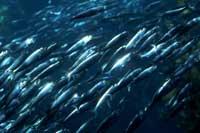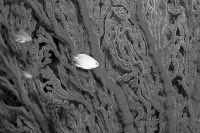Will plankton save us again from global warming?
2000/09/26 Mendiburu, Joana - Elhuyar Zientziaren Komunikazioa
it is known that the activities of being raise the temperature of the Earth. According to a new theory, phytoplankton may have a reverse influence on this process.
As a result of intense volcanic activity, about 55 million years ago, the Earth was warmer than today. As is known, the polar regions had no ice sheet. In fact, analyses of marine microorganism housings show that the water temperature on the Antarctic coast ranged from 13 to 20°C. But the only changes were not those of the warming level. Living beings also underwent changes. For example, some deep-water microorganisms suffered massive extinction, while terrestrial mammals and plankton diversified.
Two opposing theories
Prior to volcanic activity, large amounts of carbon were accumulated in ocean sediments as hydrated gases, i.e. as methane and solid crystalline water. However, by warming the ocean these hydrated gases lost balance. Methane came out and atmospheric oxygen oxidized it. As a result, the carbon released by methane further increased the amount of carbon dioxide. On a thousand-year scale, the change of time can be compared to the change that is taking place by human action.
Regional temperature changes are known to directly affect ocean movements. In fact, the temperature modifies the directions of the wind and, consequently, of the marine currents. According to the previous theory, at that time ocean traffic stagnated and solar rays gave light to less food. As a result, plankton production and photosynthesis decreased.
The theory of Oxford University researcher Bains is totally inverse. According to this researcher, the atmospheric concentration of carbon dioxide increased to 6 ° C in 30,000 years. Increased carbon dioxide boosted photosynthesis and thus increased the number of phytoplankton.
To demonstrate the proliferation of plankton, Bains highlights the great discovery of barium sulfates of the time in the ocean floor, the north of the Atlantic and the Antarctic. The main source of barium sulfate is living organisms. The new research shows a strong relationship between the rise of barium sulfate and the organic carbon that falls at the bottom of the ocean when plankton dies. Specifically, for Bains, the finding of barium sulfate indicates the death of many plankton.
On the other hand, some planktonic species that could only be found in areas of high production began to appear in many territories. Rock remains also show an important increase in biological production.
The rapid activity of plankton absorbed carbon dioxide from the atmosphere. Thus, at 60,000 years, the temperature decreased again.
It is not yet clear what theory is correct. However, although this second theory was proven, another 60,000 years would have to be expected to cool the Earth's temperature.

Gai honi buruzko eduki gehiago
Elhuyarrek garatutako teknologia






